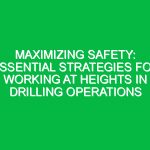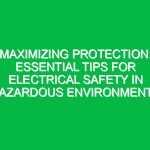Working in the oil and gas industry, particularly on oilfields, is recognized as one of the most hazardous job environments. The potential for accidents, including explosions, fires, and exposure to harmful substances, underscores the critical importance of adhering to Health Safety and Environment (HSE) protocols. Central to these protocols is the use of Personal Protective Equipment (PPE). This article delves into the essential PPE for oilfield workers, aiming to enhance their safety and well-being in such a challenging workplace.
Understanding the Risks in Oilfields
Before we explore the necessary PPE, it’s crucial to understand the risks inherent in oilfield operations. These include, but are not limited to, exposure to hazardous chemicals, risk of fire and explosion, falls from heights, and the potential for machinery-related injuries. The right PPE can significantly mitigate these risks, ensuring workers are better protected against the occupational hazards they face daily.
The Essential PPE for Oilfield Workers
Ensuring the safety of oilfield workers requires a comprehensive set of PPE. This section outlines the critical components of PPE that are indispensable for anyone working in the oil and gas extraction industry.
Head Protection
Hard Hats: A fundamental piece of PPE, hard hats protect workers from falling objects, impact with fixed objects, and even electrical shocks. For oilfield environments, it’s advisable to use hard hats that meet or exceed industry standards for impact and electrical protection.
Eye and Face Protection
Safety Glasses and Face Shields: Oilfield workers are often exposed to flying debris, chemical splashes, and potentially harmful gases. Safety glasses with side shields or full face shields are crucial to protect against these hazards.
Hearing Protection
Earplugs and Earmuffs: The heavy machinery used in oilfields can generate noise levels that pose a significant risk of hearing damage. Depending on the noise level, earplugs or earmuffs should be used to protect workers’ hearing.
Respiratory Protection
Respirators: Exposure to harmful gases, vapors, and particulates is a common hazard in oilfields. Respirators, whether half-mask, full-face, or powered air-purifying, are essential to protect workers from inhaling dangerous substances.
Hand Protection
Gloves: The variety of tasks in oilfield operations necessitates different types of gloves. Cut-resistant gloves, chemical-resistant gloves, and impact-resistant gloves are among the types that workers may need, depending on their specific tasks.
Body Protection
Fire-Resistant Clothing: Given the risk of fires and explosions, wearing fire-resistant (FR) clothing is a non-negotiable safety measure for oilfield workers. FR clothing helps to minimize burn injuries in the event of a fire.
Foot Protection
Safety Boots: Oilfield surfaces can be slippery, uneven, and sometimes contain sharp objects. Safety boots with slip-resistant soles and puncture-resistant materials are essential to protect workers’ feet from injuries.
Fall Protection
Harnesses and Lanyards: For workers operating at heights, fall protection gear is vital. This includes full-body harnesses, lanyards, and other devices designed to prevent falls or to safely arrest a fall should one occur.
Implementing a Culture of Safety
While having the right PPE is crucial, fostering a culture of safety within the oilfield environment is equally important. This involves regular training on the proper use, maintenance, and inspection of PPE, as well as encouraging a mindset where safety is always the top priority. Employers must ensure that all workers have access to the necessary PPE and understand how to use it effectively.
Staying Updated with HSE Standards
The field of Health Safety and Environment (HSE) is continually evolving, with new standards and technologies emerging. Oilfield operators and workers must stay informed about the latest HSE guidelines and PPE innovations to ensure they are using the best possible protective measures.
Summary of Key Points
Maximizing safety in oilfields is a multifaceted challenge that requires a comprehensive approach to personal protective equipment (PPE). Essential PPE for oilfield workers includes head protection, eye and face protection, hearing protection, respiratory protection, hand protection, body protection, foot protection, and fall protection gear. Beyond the provision of PPE, fostering a culture of safety and staying updated with the latest HSE standards are critical components of ensuring the well-being of oilfield workers. By prioritizing safety and equipping workers with the necessary protective gear, the oil and gas industry can significantly reduce the risks associated with oilfield operations.
Ensuring the safety of oilfield workers is not just a regulatory requirement; it’s a moral obligation. By comprehensively addressing the need for essential personal protective equipment and fostering a culture of safety, we can protect those who work in one of the most challenging and vital sectors of our economy.


